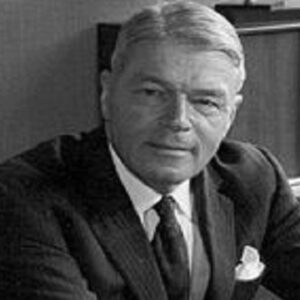Sir Cyril Astley Clarke was a British physicist and scientist who pioneered the prevention of Rh hemolytic disease of the newborn, a potentially fatal disease that can occur when a fetus and its mother have incompatible Rh factors in their blood. The medical community once believed there was no way to prevent this disease, but an enterprising doctor defied the odds by working with a dedicated team of medical professionals to develop a treatment for this dangerous condition. He was a renowned geneticist and lepidopterist as well as a highly skilled physician. His lifelong fascination with butterflies and moths began when he was a child, when he was enthralled by swallowtail butterflies. He’d get the butterflies to mate so he could study wing pigmentation and mimicry inheritance. He went on to study human genetics as a result of his childhood interest. Despite his international acclaim for his work on the prevention of Rh hemolytic disease in newborns, he also worked as a life insurance agent, a consultant physician, and a professor of medicine. He called himself a “dilettante” and thought his work was “fun,” according to his peers, who thought he was slightly eccentric. Throughout his life, he maintained a childlike curiosity and was extremely dedicated to his profession.
Childhood and Adolescence
He was born on August 22, 1907, in Leicester, England, to a medical family. He was the nephew of Percy Gee and the son of Dr. Astley Clarke, both of whom were among the University of Leicester’s founders.
Before moving to the independent Oundle School near Peterborough, he attended the Wyggeston Grammar School for Boys in Leicester. At Oundle, he was bullied and developed a strong dislike for the school.
During his school years, he developed an interest in butterflies and moths. During World War I, he was stationed in the Leicestershire village of Houghton-on-the-Hill, where his 16-year-old governess introduced him to the hobby of butterfly and moth collecting.
He chose to study Natural Sciences at the University of Cambridge’s Gonville and Caius College, where he graduated in 1929. He then went on to Guy’s Hospital in London to study medicine and surgery, graduating in 1932.
Career of Cyril
During World War II, he served as a medical specialist in the Royal Naval Volunteer Reserve. He researched severe malnutrition and the neurological complications that resulted in British POWs liberated from Japanese camps and published a paper on the subject.
Clarke went on to work as a registrar at the Queen Elizabeth Hospital in Birmingham after the war. In 1946, he was appointed as an honorary consultant physician at Liverpool’s David Lewis Northern Hospital.
In 1963, he was named Director of the Nuffield Unit of Medical Genetics at the University of Liverpool, and a few years later, he was promoted to Professor of Medicine. The teaching position suited him perfectly, and he quickly established himself as a passionate and stimulating educator. Under his leadership, the Department of Clinical Genetics flourished.
In 1967, the Royal College of Physicians elected him as a Censor, and four years later, he was promoted to Senior Censor. Clarke was made a Fellow of the Royal Society in 1970. When the previous President, Lord Rosenheim, stepped down in 1972, he was elected President of the college.
During his time as president, he ushered in a slew of changes. He started a review of the College’s constitution and made sure that the MRCP examination, which had previously been a bit of a joke, was revamped into a proper test of clinical skills.
He was part of the team that developed the technique of injecting anti-RhD antibodies into Rhesus negative women during pregnancy to prevent Rh disease in their children. This was a major medical breakthrough in the field of preventive medicine.
In 1977, his term as President of the Royal College came to an end. He founded a research unit with some of his colleagues to study the longevity and genetics of race horses.
From 1977 to 1983, he was the director of the Royal College’s medical services study group. He became the director of the research unit in 1983 and remained there until 1988.
Major Projects of Cyril
He is best known for his work on Rhesus Haemolytic Disease (RHD), also known as the “yellow baby” disease. Some of the children of Rhesus negative mothers and Rhesus positive fathers developed a potentially fatal condition that was thought to be incurable.
The brilliant doctor, on the other hand, developed anti-D, an antibody that could prevent this dangerous condition in newborns.
Achievements & Awards
In 1980, he shared the Albert Lasker Award for Clinical Medical Research with Dr. Ronald Finn, Dr. Vincent Freda, and Dr. William Pollack for their groundbreaking work on the Rhesus blood group system and the prevention of Rh disease.
Personal History and Legacy
In 1935, he married Frieda “Feo.” Their marriage was happy, and they had three sons. His wife was a strong supporter of his research and assisted him in butterfly breeding.
He’d always had a thing for butterflies and moths. He collected and bred them, and he was an expert at crossing different species; however, the Swallowtail was his favorite.
In 1998, he was devastated by the death of his beloved wife, and he never fully recovered. He lived to be 93 years old when he died on November 21, 2000.
Estimated Net Worth
What is Cyril Clarke’s net worth? Cyril Clarke is a well-known physician with a net worth estimated to be between $1 million and $9 million dollars as of 2021.


